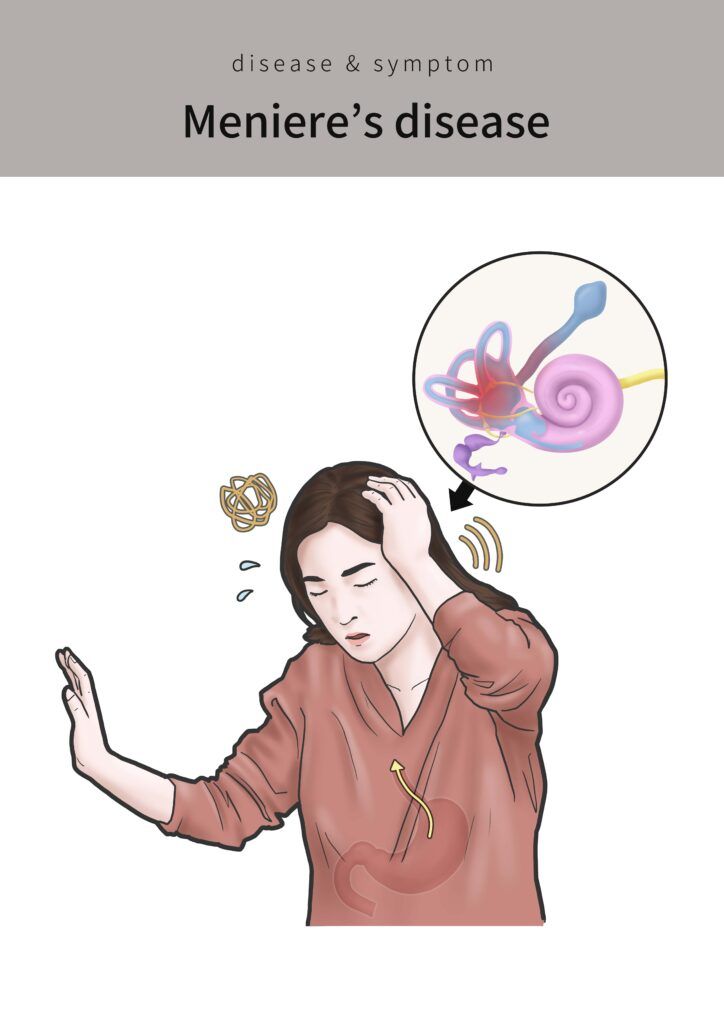Vertigo, often described as a sensation of spinning or dizziness, is a symptom that affects millions worldwide, significantly impacting their quality of life. It’s not just a feeling of being lightheaded or dizzy; vertigo can cause a perception of movement where there is none, leading to balance issues and, in some cases, nausea and vomiting. Understanding and managing vertigo is crucial, as it can stem from various underlying conditions, including inner ear disorders, neurological problems, and even migraines. This blog aims to demystify vertigo, exploring its types, causes, symptoms, and the array of management strategies available to those who experience it. By delving into the complexities of vertigo, we seek to provide valuable insights and practical advice to improve the lives of those navigating this challenging condition.
In This Blog:
- Understanding Vertigo
- Symptoms and Diagnosis
- Management and Treatment
- Living with Vertigo
Understanding Vertigo
Vertigo is more than just a simple feeling of dizziness. It’s a specific sensation of spinning or moving, even when you’re perfectly still. Imagine the room suddenly whirling around you, or feeling like you’re on a merry-go-round without ever getting on one. This disorienting experience is the hallmark of vertigo and can lead to significant distress and disruption in daily activities.
Types of Vertigo
Vertigo can be classified into two main types: peripheral and central. Peripheral vertigo is the most common form and originates in the inner ear, which plays a crucial role in maintaining balance. Issues in the inner ear, such as with the semicircular canals or vestibular nerve, can trigger this type of vertigo. Central vertigo, on the other hand, arises from problems in the brain, particularly in areas that process balance and spatial orientation, such as the cerebellum or brainstem.

Common Causes of Vertigo
Several conditions can lead to vertigo, with varying degrees of severity:
- Benign Paroxysmal Positional Vertigo (BPPV): This condition is characterized by brief episodes of intense dizziness associated with changes in head position. It’s often due to tiny calcium particles clumping in the canals of the inner ear.
- Meniere’s Disease: This inner ear disorder involves a build-up of fluid and changing pressure in the ear, leading to episodes of vertigo along with hearing loss and tinnitus.
- Vestibular Neuronitis: Inflammation of the vestibular nerve, usually following a viral infection, can cause vertigo and imbalance.
- Migraine-Associated Vertigo: People who experience migraines may also suffer from vertigo or dizziness as part of their migraine symptoms.
- Neurological Issues: Conditions like stroke or brain injuries can affect the brain’s balance centers, resulting in central vertigo.
Understanding the underlying cause of vertigo is essential for effective management and treatment. While some causes are relatively benign and easily treatable, others may indicate more serious health issues that require prompt medical attention.
Symptoms and Diagnosis
The symptoms of vertigo can extend beyond the characteristic spinning sensation, often being accompanied by other disruptive and sometimes alarming signs. Commonly, individuals experiencing vertigo may also report nausea, vomiting, headache, sweating, ringing in the ears (tinnitus), or hearing loss. These symptoms can vary in intensity and duration, significantly affecting one’s ability to perform daily activities and reducing overall quality of life.
Diagnosing vertigo involves a comprehensive approach that starts with a detailed medical history and physical examination. Healthcare providers typically inquire about the onset, duration, severity, and the circumstances surrounding the episodes of vertigo. Understanding these aspects helps differentiate between peripheral and central vertigo and can guide further diagnostic procedures.
Key diagnostic steps include:
- Physical Examination: This may include testing eye movements, as abnormal eye movements can often accompany vertigo. The Dix-Hallpike test, for example, is specifically used to diagnose BPPV by moving the patient’s head into certain positions and observing the resulting eye movements.
- Hearing Tests: Since many vertigo cases are related to inner ear disorders, audiometric tests can assess whether hearing loss is present.
- Balance Tests: Various balance tests, such as the Romberg test, can help determine the cause of vertigo by assessing the body’s sense of positioning.
- Imaging Studies: In cases where a central cause is suspected, imaging techniques such as MRI or CT scans may be necessary to identify any abnormalities in the brain.
The process of diagnosing vertigo is crucial as it directly influences the treatment strategy. Accurate diagnosis ensures that treatment is tailored to the specific underlying cause, thereby increasing the effectiveness of the interventions and reducing the likelihood of recurrence.
Management and Treatment
Effectively managing and treating vertigo involves a combination of lifestyle adjustments, home remedies, and medical interventions. The approach can vary significantly depending on the underlying cause of vertigo, its severity, and the specific symptoms experienced by the individual.
Lifestyle Adjustments and Home Remedies
For many suffering from vertigo, simple changes in daily habits can significantly alleviate symptoms:
- Epley Maneuver for BPPV: This series of movements, typically guided by a healthcare professional at first, can help dislodge the tiny particles in the inner ear that cause vertigo in BPPV. After learning the maneuver, patients can perform it at home to manage episodes.
- Diet and Hydration: Reducing salt intake can help manage Meniere’s disease, while staying well-hydrated is beneficial for general vestibular health.
- Stress Management: Techniques such as yoga, meditation, and controlled breathing can help reduce stress, which may trigger vertigo episodes in susceptible individuals.
Medical Treatments
When lifestyle adjustments are not sufficient, medical treatments may be necessary:

- Medications: Various medications can be used to relieve the symptoms of vertigo, nausea, or motion sickness. In some cases, medications are also prescribed to treat the underlying conditions, such as antiviral drugs for vestibular neuronitis or migraine prevention medications for migraine-associated vertigo.
- Physical Therapy and Vestibular Rehabilitation: Vestibular rehab is a specialized form of therapy aimed at strengthening the vestibular system, improving balance, and reducing the frequency and severity of vertigo episodes. It involves exercises that help the brain adapt to and compensate for whatever is causing the vertigo.
- Surgical Options: In severe cases where vertigo does not respond to other treatments, surgery may be an option. Procedures may focus on correcting abnormalities in the inner ear or, less commonly, in the brain.
The goal of managing vertigo is not only to treat acute episodes but also to reduce their frequency and impact on daily life. Regular follow-ups with healthcare providers are essential to monitor progress and make adjustments to the treatment plan as needed. Effective management requires a proactive approach, often involving multiple strategies to ensure the best possible outcome.
Living with Vertigo
Adapting to life with vertigo involves understanding your triggers, making appropriate lifestyle changes, and maintaining open communication with your healthcare providers. Here are some practical tips for managing daily life and minimizing the impact of vertigo:
Tips for Daily Living
- Avoiding Triggers: Identify and avoid activities or movements that trigger vertigo episodes. This may include avoiding rapid changes in position, such as quickly turning the head or standing up too fast.
- Home Safety: Make your home safer to navigate during vertigo episodes by securing loose rugs, installing handrails in necessary areas, and ensuring good lighting.
- Driving and Operating Machinery: Be cautious about driving or operating heavy machinery. Discuss with your doctor the safety of these activities given your condition.
- Visual Aids: Some people find relief by focusing on a stationary object during vertigo episodes. This technique, known as “gaze stabilization,” can help manage symptoms until the episode passes.
Importance of Patient Education and Support Groups
Education about vertigo and its management can empower patients to take an active role in their treatment. Learning more about the condition helps demystify symptoms and reduce anxiety associated with unexpected episodes. Furthermore, joining support groups, either online or in-person, can provide valuable insights and emotional support from others who understand the challenges of living with vertigo.
When to Seek Medical Help
While many vertigo episodes are manageable at home, it’s important to know when to seek medical help:
- Severe Symptoms: If vertigo is accompanied by severe headache, double vision, weakness, trouble speaking, or other neurological symptoms, seek immediate medical attention.
- Persistent or Worsening Symptoms: If symptoms persist or worsen despite treatment, a reevaluation by a healthcare provider may be necessary to adjust treatment strategies or investigate other underlying causes.
Living with vertigo requires patience and adjustments, but with the right strategies and support, individuals can lead fulfilling lives while effectively managing their symptoms.
Conclusion
In conclusion, vertigo is a complex condition with a wide range of causes and manifestations, but understanding and effectively managing it can significantly improve one’s quality of life. By exploring the nature of vertigo, its causes, symptoms, and the available treatment options, individuals can better navigate their experiences with this disorienting symptom. Embracing a combination of lifestyle changes, medical interventions, and supportive strategies is key to mitigating the impacts of vertigo. It’s important to maintain ongoing communication with healthcare providers to tailor treatments as needed and to seek immediate medical attention for severe or unusual symptoms. With the right approach, those affected by vertigo can achieve greater stability and comfort in their daily lives.

Dr. Kashouty, a diplomate of the American Board of Psychiatry and Neurology (ABPN), practices general neurology with fellowship trained specialization in clinical neurophysiology. Dr. Kashouty finds the form and function of the nerves and muscles the most interesting part of neurology, which is what led him to specialize in neurophysiology with more emphasis on neuromuscular conditions. He treats all neurological diseases, but his main focus is to treat and manage headaches, movement disorders and neuromuscular diseases.




